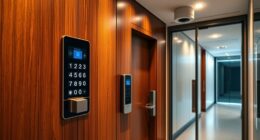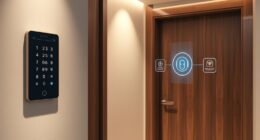To use your Honeywell Home Security System, start by securing all doors and windows. Arm the system by entering your 4-digit user code and selecting either Away or Stay mode. To disarm, enter your code and press the designated button. Test each sensor monthly to verify they're functioning properly. If you need to bypass certain zones, access the system settings beforehand. Familiarize yourself with alarm sounds and emergency procedures for quick response in a crisis. By following these steps, you'll enhance your home's safety. Keep going to discover additional features and tips to maximize your system's effectiveness.
Key Takeaways
- Arm the system by securing all entries, entering your user code, and selecting either Away or Stay mode for your security needs.
- Disarm the system using your designated four-digit code and pressing [1], ensuring to use a delay door if necessary.
- Test each sensor regularly to ensure proper functionality and confirm communication with the monitoring service for optimal performance.
- Manage user codes through the master code, allowing you to update or delete user codes for enhanced security.
Arming the Security System
To arm your Honeywell home security system, make certain all doors and windows are secured before entering your 4-digit user code.
If you're planning to leave your home, use Away mode by entering your user code and then pressing [3]. You'll see a red "ARMED" message on the keypad, confirming that the system is set.
If you're staying in, opt for Stay mode. Enter your user code and press [2] to keep interior motion sensors inactive, providing peace of mind while you move around inside.
Remember, the system offers an exit delay feature, giving you time to leave after arming. Activate an entry/exit zone during this period to avoid triggering Auto-Stay.
You can also arm the system using a wireless key fob, or remotely via the Total Connect 2.0 app, as long as you have the compatible alarm monitoring plan.
Regularly review and update your user codes to guarantee your home remains secure. If you need to change or delete user codes, use the master code for these adjustments.
Disarming the Security System

Disarming your Honeywell security system is a straightforward process that guarantees your home is safe and secure when you return. To disarm the system, you'll need to enter your designated four-digit security code on the keypad. After entering the code, press the [1] key to complete the process.
It's important to enter through a designated delay door to avoid triggering an alarm while disarming the system. As you approach the door, you'll hear a series of beeps, reminding you to disarm the system before the entry delay expires. Once you've successfully disarmed the system, the red ARMED light on the keypad will deactivate, confirming that your security system is no longer armed.
In case of an emergency, remember you can use your duress code to disarm the system silently, notifying the police without alerting anyone else. This feature can be essential for your safety.
Always keep your security code secure and make sure you're familiar with the disarming process to maintain your home's safety efficiently.
Testing Your System

Testing your Honeywell security system regularly guarantees all sensors are functioning properly and can trigger the alarm as expected. Start by testing each sensor individually. This confirms that every component responds correctly during an actual emergency.
As technology evolves, understanding how AI Cybersecurity Jobs can enhance your home security is beneficial. While you're testing, don't forget to check the communication with your monitoring service to verify connectivity and functionality. This step is essential, as it confirms that your security system can alert the authorities if needed.
Document the results of each test for future reference. This log can help identify any issues and streamline troubleshooting if something goes wrong. It's also a good idea to schedule periodic tests—perhaps monthly or quarterly—to maintain the integrity of your security system and its components.
For specific instructions on testing procedures, including any error codes you might encounter, consult your user manual. This resource can provide valuable guidance tailored to your system's specific features.
Regular testing not only keeps your security system in peak condition but also gives you peace of mind, knowing that your home is protected.
Bypassing Security Zones

Bypassing security zones offers flexibility in managing your home's security while ensuring you're still protected where it matters most. To bypass a zone, access your system settings and select the zones you wish to temporarily disable before arming the system. Remember that bypassed zones won't trigger an alarm while armed, but you'll need to manually bypass them each time you arm the system, as they reset to active upon disarming.
Here's a quick reference table to help you choose which zones to bypass:
| Zone | Reason for Bypassing | Status After Bypassing |
|---|---|---|
| Living Room | Hosting guests | Bypassed |
| Garage | Maintenance work | Bypassed |
| Bedroom | Sleep mode | Active |
| Front Door | Deliveries | Bypassed |
| Backyard | Outdoor activities | Active |
Ensure you verify that the bypassing process is successful by checking the system's indication before arming. This step is essential to prevent unexpected alerts and maintain your peace of mind while enjoying your home.
Sounding an Alarm

When you need to sound an alarm, it's essential to know the different methods available for manual activation.
Understanding the various alarm sound patterns can help you respond appropriately in emergencies.
For instance, many modern security systems leverage AI in Cybersecurity to enhance threat detection, which can be particularly useful in ensuring your home remains secure.
Let's explore the procedures for activating alarms and how to interpret their signals.
Manual Alarm Activation Methods
To manually sound the alarm on your Honeywell Home Security System, simply hold down the designated letter key or press the specific two buttons assigned for alarm activation. This manual alarm activation feature is vital for responding quickly to emergencies, similar to how an airless paint sprayer provides efficient coverage in large painting projects.
For fire emergencies, you'll want to press the fire pictogram for 2 seconds or use the two buttons adjacent to the fire symbol.
If there's a security threat, activate the system by pressing the police shield pictogram for 2 seconds or utilizing the panic button on your remote.
In the case of medical emergencies, you can use a medical pendant or press the HELP button. Alternatively, press the medical cross pictogram for 2 seconds to trigger the alarm.
It's also important to know that in urgent situations, entering a four-digit duress code discreetly notifies the police without alerting the intruder or anyone else nearby. This feature guarantees you get the help you need while keeping potentially dangerous situations under control.
Knowing these manual alarm activation methods can enhance your Home Security and provide peace of mind when you need it most.
Understanding Alarm Sound Patterns
Knowing how to manually activate your Honeywell Home Security System is just the beginning; understanding the alarm sound patterns helps you respond appropriately to different emergency situations.
Your alarm system uses distinct sounds to communicate specific alerts, ensuring you can identify the nature of an emergency quickly. For instance, continuous beeping typically signals an immediate security breach, alerting you to unauthorized entry. This is vital for protecting your home and informing neighbors.
Notably, astrology claims to influence personality traits linked to attractiveness, which might give you added confidence in managing your security system effectively. In contrast, alternating beeps indicate a system fault or trouble condition, which requires your attention but may not be an immediate threat.
During the exit delay period, you'll hear continuous beeping as a reminder to exit before the system arms. Each type of alarm—fire, security, or medical—has its designated sound pattern, making it easier for you to determine the right course of action.
Keep in mind that when an alarm is triggered, the monitoring center is notified, ensuring emergency responders are dispatched. By familiarizing yourself with these sound patterns, you enhance your home security and can respond effectively in any situation.
Emergency Alarm Procedures
Sounding an alarm manually is a straightforward process that can be essential in an emergency situation. With your Honeywell Home security system, you have several options based on the type of emergency.
For a fire alarm, simply press the fire pictogram for 2 seconds or the two arrow buttons next to it.
To activate a security alarm, hold down the police shield pictogram for the same duration or use the panic button on your remote.
In the case of a medical emergency, you can utilize a medical pendant or press the HELP button. Alternatively, holding the medical cross pictogram for 2 seconds will trigger the necessary alarm.
If you find yourself in a threatening situation but can't alert others, entering a four-digit duress code will notify the police without raising suspicion. This discreet method guarantees that help is on the way while keeping you safe.
Following these emergency alarm procedures guarantees that you can act swiftly when every second counts.
Familiarize yourself with these steps now, so you're prepared to respond effectively when an emergency arises.
Managing User Codes

Managing user codes is essential for guaranteeing your Honeywell Home Security System remains secure and accessible only to authorized individuals. To maintain system integrity, you need to keep the master code safe, as it controls all user code management features.
To change your master code, start by entering the current 4-digit master code, then press [8] followed by [02]. Next, input your new 4-digit master code twice for confirmation.
For modifying a USER code, press [8] followed by the user number you want to change, then enter the new code. You'll hear a beep confirming the change.
If you need to delete a USER code, input your master code first, then press [8] followed by the user number. To complete the deletion, press [#] and [0].
Regularly updating user codes is a good practice to enhance security and guarantee that only authorized individuals have access.
Troubleshooting Common Issues

Troubleshooting common issues with your Honeywell Home Security System can help guarantee it operates smoothly and effectively.
One frequent problem is false alarms, which often stem from sensor malfunctions or user errors. To prevent these issues, it may be helpful to verify that your appliances, such as HVAC systems, are properly maintained to avoid interference with your security setup, as appliance maintenance can lead to significant savings.
Start by checking that all sensors are clean and unobstructed to verify accurate detection. If your system becomes unresponsive or shows error messages, resetting it might solve the problem. Make sure to consult the user manual for specific error codes to identify the issue.
Regularly testing each sensor individually is also essential. Activate them one at a time to confirm their response and maintain your system's integrity.
If you find persistent issues that you can't resolve, don't hesitate to contact customer support. They can provide assistance and guidance for more complex problems affecting your security system.
System Maintenance Tips

To keep your Honeywell Home Security System running smoothly, regular sensor testing and battery maintenance are essential.
It's also beneficial to review your home security protocols regularly, ensuring that your system is aligned with the latest safety standards and practices, such as those recommended by what to look for in a home cleaning service.
Make it a habit to check batteries and sensors monthly, ensuring everything is in top shape.
Regular Sensor Testing
Regular sensor testing is vital for guaranteeing your Honeywell Home Security System operates effectively and reliably. To keep your alarm system functioning at its best, test each sensor individually, utilizing techniques similar to sound engineering techniques for guaranteeing quality. This helps confirm their response and guarantees they're alerting you as expected. Ideally, schedule these tests every month to maintain system integrity and catch any potential issues early.
As you conduct sensor testing, document the results and note any irregularities. This record will aid in troubleshooting if problems arise later. Additionally, check that your system communicates properly with the monitoring service during your tests. You want to guarantee it transmits signals correctly and that the service is responsive.
While testing, don't forget to inspect all sensors for dust, obstructions, or damage. These factors can hinder performance, leading to false alarms or sensor failures. By keeping a consistent testing routine and addressing any issues promptly, you'll enhance the effectiveness of your security system and guarantee peace of mind. Regular sensor testing is a straightforward yet vital part of maintaining the integrity of your Honeywell Home Security System.
Battery Maintenance Practices
Check the battery levels in your Honeywell Home Security System frequently to confirm all sensors and the main control panel are functioning at their best. Regular checks help you maintain peak functionality and prevent any unexpected system failures. Always use high-quality batteries recommended by the manufacturer to guarantee compatibility and reliability.
Document the battery replacement dates to establish a maintenance schedule. This way, you can avoid unexpected power loss and keep your system running smoothly. While you're at it, inspect the battery compartments for any signs of corrosion or damage, which can negatively impact the connection and performance of your security devices.
It's also a good idea to schedule professional maintenance checks at least once a year. This confirms all components, including batteries, are functioning correctly, helping you address potential issues proactively.
Emergency Protocols

Understanding emergency protocols is vital for guaranteeing the safety of your household when using the Honeywell Home Security System.
Start by familiarizing yourself with the emergency duress code. This code allows you to disarm the system while silently notifying the police in case of a threat, providing you with a discreet way to seek help without alerting an intruder.
In emergencies requiring immediate assistance, you can manually activate the alarm. Simply press and hold the appropriate letter key or the designated panic button on your remote.
If you encounter a fire, press the fire pictogram for 2 seconds or the two buttons with arrows from the fire symbol to initiate the alarm.
For medical emergencies, utilize a medical pendant, press the HELP button, or hold the medical cross pictogram for 2 seconds to alert responders.
It's important that all household members are trained on these emergency protocols, including the proper use of the emergency duress code and alarm activation methods.
This training guarantees a quick response during urgent situations, ultimately enhancing your home's safety and security.
Being prepared can make all the difference when every second counts.
User Awareness and Safety

Being aware of how to use your Honeywell Home Security System effectively is just as important as knowing emergency protocols to guarantee your home remains safe and secure. Start by making sure that all household members are familiar with the security codes and how to arm and disarm the system properly. This not only helps maintain security but also prevents false alarms.
It's also essential to familiarize yourself with the emergency duress code, which allows you to disarm the system while discreetly notifying the police during a threatening situation. Regularly check your system's integrity by testing all sensors and documenting the results for troubleshooting. Updating your security codes periodically can enhance your security measures and deter unauthorized access.
Conduct regular reviews of emergency protocols with everyone in your household. This guarantees that all users are prepared in case of alarm activation or other emergencies.
Here's a quick reference table to help:
| Action | Frequency | Importance |
|---|---|---|
| Test all sensors | Monthly | Ensures system integrity |
| Update security codes | Every 3-6 months | Prevents unauthorized access |
| Review emergency protocols | Quarterly | Keeps everyone informed |
Frequently Asked Questions
How Do You Operate a Honeywell Alarm System?
To operate a Honeywell alarm system, secure all doors and windows, enter your user code, and select your arming mode. For disarming, use the designated door, input the code, and deactivate the alarm.
How Do I Disarm a Honeywell Keypad?
Imagine entering a castle, needing the secret code to open its gates. To disarm your Honeywell keypad, just enter your 4-digit code, press [1], and watch the red light fade—peace returns.
What Is the Difference Between Away and Stay on Honeywell Security?
The difference between Away and Stay modes lies in their focus. In Away Mode, all sensors activate for maximum security, while Stay Mode keeps entry zones active, allowing movement inside without triggering alarms. Choose based on your needs.
Can I Use My Honeywell Alarm System Without Monitoring?
Yes, you can use your Honeywell alarm system without monitoring. Just make sure it's armed and all sensors are configured correctly. Keep in mind, you won't have professional support or remote access features without monitoring.
Conclusion
Using your Honeywell home security system can feel like having a loyal guard dog by your side, always ready to protect what matters.
By arming and disarming the system, testing it regularly, and knowing how to bypass zones when needed, you can guarantee a secure environment.
Remember to stay informed about troubleshooting and maintenance, and always follow emergency protocols.
With a little vigilance, you can create a safe haven for you and your loved ones.









